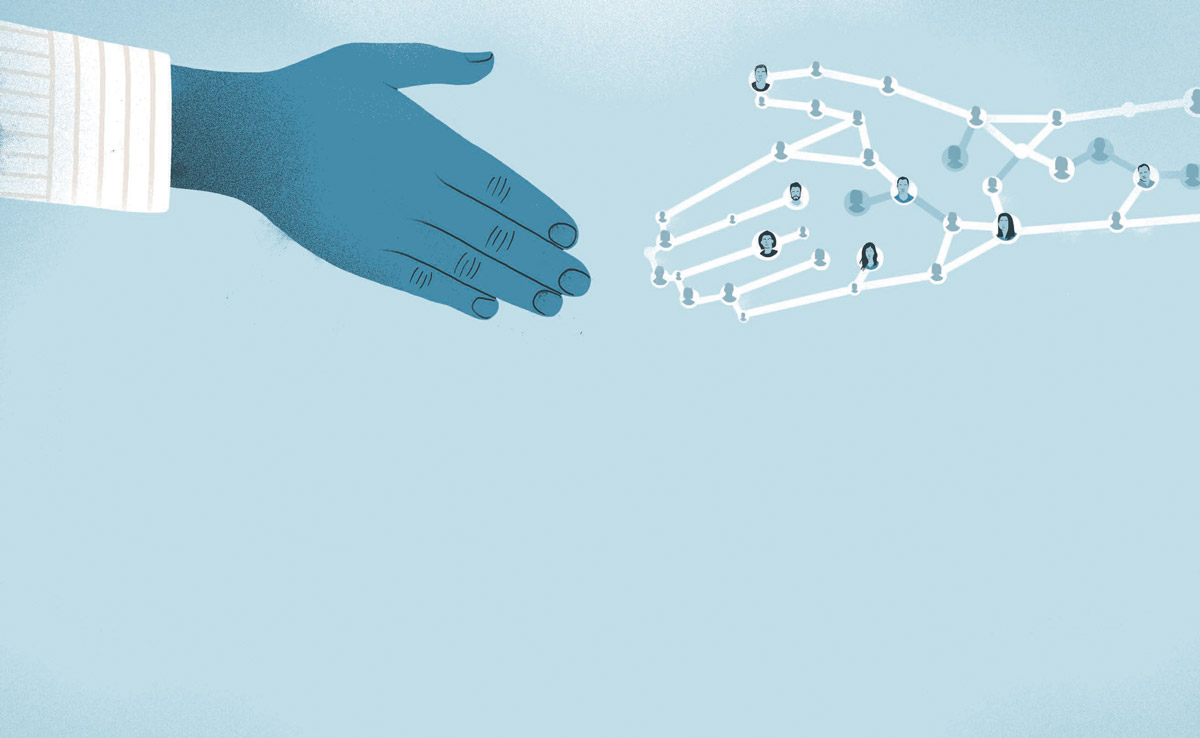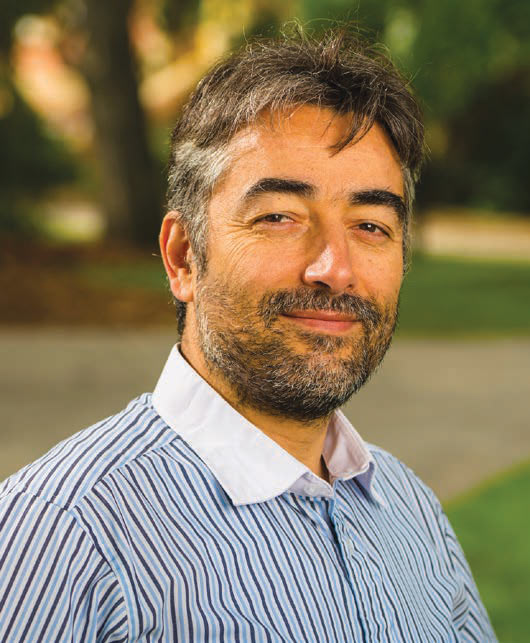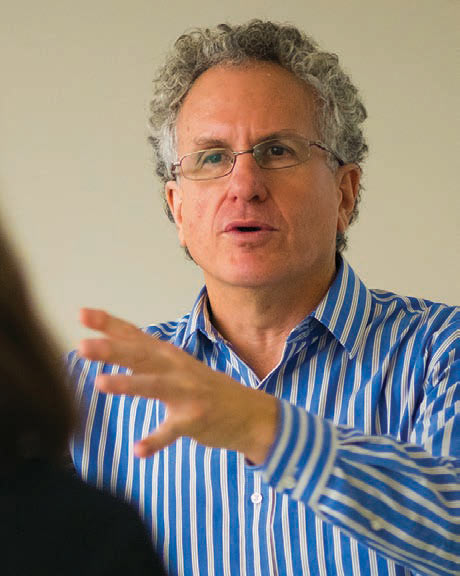
Read more: "Degrees of Separation in Social Networks," published in the Proceedings of the Fourth International Symposium on Combinatorial Search, is available online via Google Scholar.
"People you may know..." "I didn't know you were friends with so-and-so!" "Add this person to your network." "So, how do you know so-and-so?" "Connect with this group online."
Whether it's online or in real life, social networks are everywhere-from your workplace to Snapchat to last week's dinner party and everything in between. And every such network has a few things in common.
There are a series of actors, also called nodes. Most commonly, we think of these as individual people, but they can also be places, events, or things. Next, there are connections between the actors. These can be friendships, professional relationships, family ties, or simply coincidences of being in the same place at the same time. Finally, there are degrees, or the number of connections an actor has.
In the late 1920s, Hungarian writer Frigyes Karinthy first set forth the notion of the small-world paradox, suggesting that there are up to six degrees between any two people on the planet.
Whether you've heard it called the small-world paradox, six degrees of separation, Malcolm Gladwell's influencers, or even the Kevin Bacon effect, you're likely familiar with Karinthy's theory. And, mind-boggling though it is, research shows that as our population grows, the degrees of separation between us become increasingly small.
Closer than you think
For computing scientists, there is nothing strange about the concept of social networks and network analysis. Social networks, says computing science professor and Dean Jonathan Schaffer, are really just graphs in disguise.
Familiar strangers
In 1972, experimental psychologist Stanley Milgram explained the familiar stranger, a person with whom you regularly cross paths but do not interact. Milgram's "aspect of urban anonymity" is one we've all encountered. Whether it's someone on public transit or a face that continues to crop up on social media, each of us has a familiar stranger or two in our lives.
"Degrees of Separation in Social Networks," published in the Proceedings of the Fourth International Symposium on Combinatorial Search.
"Relationships between people can be represented in very large, connected graphs. When considering degrees of separation, we're talking about the shortest distance between point A and point B on that graph."
An expert in heuristic search algorithms, Schaeffer explains that understanding the properties of these graphs, whatever type of network they may depict, is important in computing science. And in the world of the Web 2.0, where social media such as Facebook, Twitter, LinkedIn, Instagram, and Snapchat abound, our digital social networks are changing these graphs-and our networks- dramatically.
"Digital social networks are much more diverse and interconnected than non-digital networks," says Schaeffer. "They transcend all sorts of boundaries, such as geography and traditional social circles. People connect for all sorts of reasons and in all sorts of places, where in-person connections may never have been made."
In fact, a paper published by Schaeffer and colleagues in 2011 showed that there were just 3.44 degrees of separation between users on Twitter-nearly halving Karinthy's original hypothesis.
"The more people we have on this planet, the more connections we have, and the closer we become to one another," explains Schaeffer. And this phenomenon is only on the rise.
Vast applications
Note: Social networks are not social media
Social media platforms, such as Facebook, Twitter, and Instagram, are not social networks in and of themselves. "Social media generates social graphs that demonstrate our social networks, but they are not social networks themselves," says computing science professor Osmar Zaiane. Rather, social networks can exist on social media, or be supported by it. And some of our most valuable networks are, in fact, offline. On that note, check out how scientists are taking advantage of the network opportunities via social media.
An expert in data management and information mining, Osmar Zaiane is familiar with the power of social networks in our modern era.
"If we have data that shows the relationships between entities, we can use social-network analysis to learn a great deal about it," says Zaiane, computing science professor and scientific director of the Alberta Machine Intelligence Institute (AMII) at the University of Alberta. "Think everything from Netflix recommendations to health-screening behaviours."
When we understand how actors interact and, more specifically, how actors with similar features interact, we can begin to understand network characteristics, ranging from power relations to other connections we didn't even realize were there.
Biologists can use social-network analysis to understand the ways that different proteins interact with one another. Businesses can discern customer behaviour both with products and services as well as in interactions with other clients. Public health practitioners can track health outcomes. Linguists can demystify the connections between languages throughout history. Netflix users can receive better-thanever recommendations based on their peers. Are you still watching?
Everyone you never knew you'd know
But for Zaiane, the most exciting implications behind social-network analysis lie in our new-found ability to see the future . . . kind of.
"Predictive social-network analysis allows us to anticipate connections between two actors," Zaiane explains. While not quite forecasting the future, the ability to make predictions between people, events, and places has huge implications for many fields. Take criminology, for example.
"Say you have mapped the criminal activity of a certain network, outlining events, people, places, and objects," says Zaiane. "Using predictive analysis, we can see who may not be connected now but may be connected in the future. Retroactively, we can also see who may have been connected in the past, but is no longer connected now."
There is a great deal of information in social networks of all kinds. Now, social-network analysis is the tool for tapping into that wealth of knowledge.
"Technology allows us to identify and exploit the relationships between actors-whether for scientific gain, movie recommendations, or even to understand crime."
Get (net)working
Whether fighting crime or simply connecting on LinkedIn, understanding and building networks is a powerful tool and a useful skill.
"In academia, as in business, building a personal network can pay huge dividends," says Schaeffer. "These networks exist personally, professionally, academically, and in our other areas of interest. It's all the more remarkable when they begin to intertwine."
By engaging across disciplines, social networks in academia can help researchers to solve problems beyond their own expertise and produce technologies, projects, and discoveries that simply would not have been possible before.
"Sometimes, the biggest value of a university education is the connections made and the networks built therein," says Schaeffer. "Maybe they'll be personal, connecting you to a new friend or future spouse. Maybe they'll help you find a job or form a startup company. Maybe they'll enrich your life through volunteerism."
As an alumnus from the Faculty of Science, you are one of 43,721 living alumni in more than 100 countries worldwide. And, as an alumnus from the University of Alberta, you are also part of a network of more than 275,000 alumni living in 140 countries. In turn, you are connected to more than 70,000 organizations around the world that have been founded by this group, an astounding association indeed. While you may not personally know your 43,720 fellow science alumni, you share a few great things in common-your alma mater, the city of Edmonton, and the Faculty of Science.
Though the mountains are high and the oceans are wide, it really is a small world after all.

